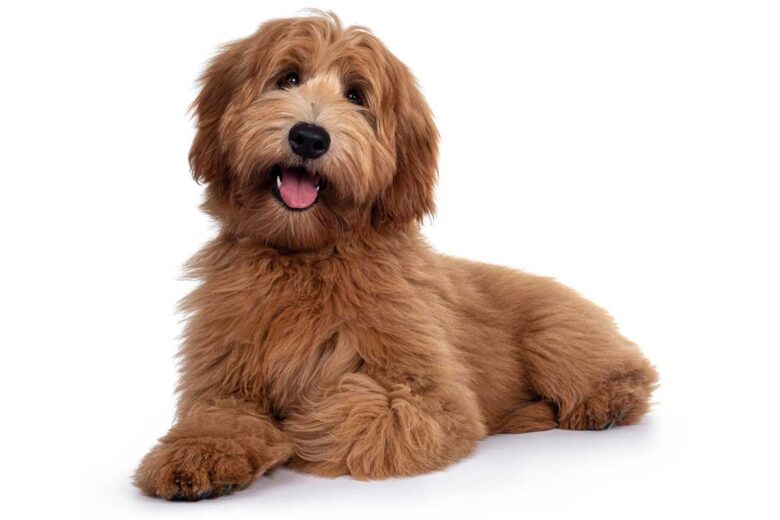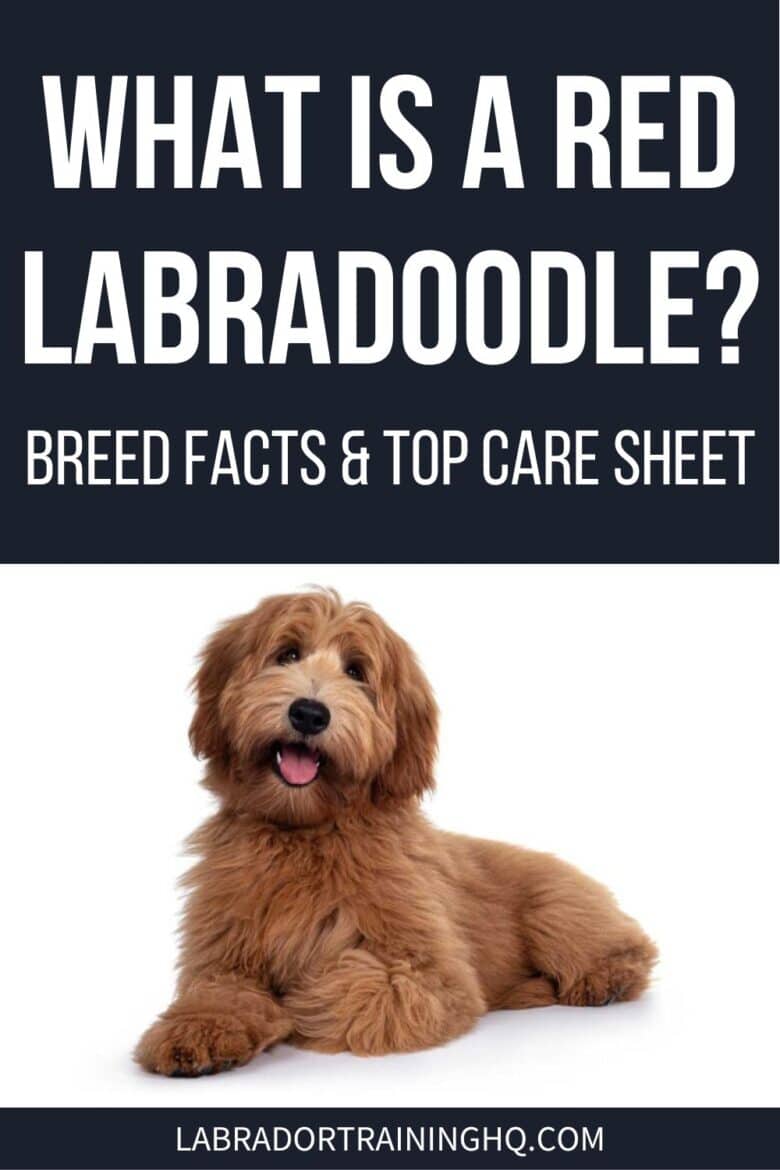This post may contain affiliate links. We may earn money or products from the companies mentioned in this post.
The red Labradoodle comes from crossing a red or apricot poodle with a cream Labrador retriever or two red Labradoodles.
The red coloration of the coat has to come from the poodle parent in the initial cross breeding as Labradors do not have naturally red coats.
Red Labradoodle puppies are adorable teddy bear-like bundles of joy. However, they do grow up to be sizable bears who need people or other pets around them to feel secure.

This means they need someone in the home with them for the majority of the day.
Red Labradoodles have a medium to intensive grooming schedule depending on whether they are more like their poodle parents and are low-shedding or are more like their Labrador parents and shed as easily as they wag their tail for a treat.
Read on to learn what makes a red Labradoodle a red Labradoodle and if it is the right dog for you.
Main Characteristics
Before we get into the details, let’s take a quick look at the main characteristics of the Labradoodle.
Parent breeds: Labrador retriever and poodle
Height: Standard 20 to 25 inches
Weight: Standard 50 to 60 pounds
Lifespan: 12 to 15 years
Coat type: Medium to long, very curly to wavy
Coat color: pale ginger to deep auburn
Key characteristics: Good with children, easily trained, may be hypoallergenic/low shedding, highly intelligent, lots of grooming needed, good with other pets, requires lots of exercise
Parent Breed History
To better understand the hybrid offspring of the Labrador retriever and the poodle, we need to understand where their parent breeds come from and their key characteristics.
Poodle Breed History
The poodle was bred by German and French waterfowl and small game hunters in the 18th century. The poodle would accompany the hunter, and once the prey had been shot down, the poodle would speed away and fetch the prey whether it was in freezing cold water or dense thickets.
The standard poodle is quite tall with long legs, which helped it see over underbrush and spot the downed prey. In addition to their long legs, their coats were bred to be thick and dense to protect their joints and organs from the cold European waters.
The poodle comes in three size varieties: the standard, the miniature, and the toy poodle. Regardless of the size of the dog, the poodle is an energetic hunting dog who needs plenty of exercise and care.
Here is a breakdown of the main characteristics of the poodle:
| Characteristic | Poodle |
| Trainability | |
| Health | |
| Grooming Needs | |
| Good With Children | |
| Good With Other Dog Breeds | |
| Energy Levels | |
| Exercise Requirements | |
| Barking Frequency |
Labrador Retriever Breed History
The Labrador retriever is native to Newfoundland, Canada. It was bred to be the perfect companion to waterfowl hunters through the late 18th century into the 19th century.
When hunters from England visited Canada, they found the retrievers to be captivating and took some home.
There, the hunters refined the breed and called it the Labrador retriever–ironically named since it actually came from Newfoundland!
The Labrador retriever would accompany the waterfowl hunters and dive into the icy waters of lakes and the North Atlantic sea to retrieve the birds once they had been shot down.
Labrador retrievers were perfectly suited to this job, as their thick double coats would protect their bodies from the cold water, and their thick, strong tails would help them turn and maneuver while swimming.
Here is a breakdown of the main characteristics of the Labrador retriever:
| Characteristic | Labrador Retriever |
| Trainability | |
| Health | |
| Grooming Needs | |
| Good With Children | |
| Good With Other Dog Breeds | |
| Energy Levels | |
| Exercise Requirements | |
| Barking Frequency |
How Did The Red Labradoodle Come Into Being?
The poodle is known for its low-shedding and relatively “hypoallergenic” coat. To be clear, no dog is truly 100% hypoallergenic. However, the poodle is as close as you could get to it because their coats do not shed.
The Labrador retriever is a tried and tested service dog for people with disabilities. They are incredibly intelligent, easily trained, and friendly dogs.
Basically, the thought process behind creating the Labradoodle was: “if we combined the Labrador’s brains and ability to act as a service dog with the coat of the poodle, could we get a hypoallergenic service dog with all the intelligence of both breeds?”
The answer was, of course, yes, and the Labradoodle has been a favorite among many service dog communities ever since.
The Labradoodle has also gained popularity as a hybrid breed in regular families because of their adorable teddy-bear-like faces and intelligent eyes.
Unfortunately, there isn’t a lot of consistency in the hybrid. They tend more towards the poodle side or the Labrador side, and there can be a large variety in a single litter.
One red Labradoodle puppy may be very low shedding, and another may shed every single day.
This means it is up to the individual dog whether they are considered good service dog material or not.
What Does A Red Labradoodle Look Like?
As I touched on earlier, there can be a lot of variation between different Labradoodles. Let’s take a look at what you can expect from the average Labradoodle’s size and coat.
Size
Red Labradoodles take on the size of the parent poodle. As mentioned earlier in this article, there are three size variations of the poodle.
If a Labrador retriever is bred with a:
- Standard poodle, it should be between 22 and 24 inches tall
- Miniature poodle, it should be between 18 and 20 inches tall
- Toy poodle, it should be between 14 and 16 inches tall
Coloration
Let’s get down to the red part of the red Labradoodle.
Labradors come in three distinct colors:
- Black
- Yellow/cream
- Chocolate
You would get the best “red” result by using a yellow or cream Labrador in breeding the Labradoodle.
Poodles come in many different colors:
- Apricot
- Black
- Blue
- Brown
- Cafe au lait
- Cream
- Gray
- Red
- Silver
- Beige
- White
To get a red Labradoodle, the original poodle parent would have to be red or apricot in color. In successive generations, a red Labradoodle could be bred with another red Labradoodle or a different poodle with a red coat to produce offspring with a deeper red coat.
What Kind Of Temperament Does A Red Labradoodle Have?
In terms of their overall temperaments, Labradoodles can sway between the two parent breeds quite freely.
This means you may get a Labradoodle that is more rambunctious and silly like the Labrador, or you may get a more cool, calm, and collected one like the poodle.
However, looking at the majority of Labradoodles, they are fun-loving dogs who adore their families, enjoy being around groups of people, do not like being left alone, and will take on as many tasks as you can give them.
Caring For Your Red Labradoodle
Owning a dog is a privilege, and caring for their grooming and exercise needs is a non-negotiable responsibility. Let’s take a look at what that responsibility means if you own a red Labradoodle.
Grooming
Labradoodles take on the wavy to curly textured coat of the poodle. This means they need to be brushed at least twice a week to prevent the coat from matting, becoming compacted, pulling on the skin, or causing sores to develop.
As mentioned previously, Labradoodles may be low shedding or they may shed daily; it is simply the luck of the draw.
If your Labradoodle sheds daily, their coat will need to be brushed daily, too. In addition, if their coat grows quickly like their poodle parent, they will need a haircut every two to three months to keep them comfortable.
Exercise
Labradors and poodles are both high-energy dogs. The Labradoodle is not different. Your Labdradoodle requires an hour of exercise every day to maintain its physical health as well as tire it out mentally.
Exercise can take the form of walks, hikes, training, obstacle courses, or playing fetch. Labradoodles do need space to stretch their legs, so apartments and condos are not ideal living spaces.
FAQs About Red Labradoodles
When are red Labradoodles considered full grown?
A Labradoodle is considered an adult or full grown when it is two to three years old. For a more detailed look at the Labradoodle’s lifespan and life stages, check out our dedicated article.
Barking Off On Red Labradoodles…
Red Labradoodles are beautiful dogs who have a lot of love and affection to give their families. These dogs are the product of a cross between a red poodle and a cream labrador or successive breeding of red Labradoodles.
Let’s do a quick recap of their main characteristics of red Labradoodles:
Parent breeds: Labrador retriever and poodle
Height: Standard 20 to 25 inches
Weight: Standard 50 to 60 pounds
Lifespan: 12 to 15 years
Coat type: Medium to long, very curly to wavy
Coat color: Pale ginger to deep auburn
Key characteristics: Good with children, easily trained, may be hypoallergenic/low shedding, highly intelligent, lots of grooming needed, good with other pets, requires lots of exercise
As they are a hybrid dog breed, there is no guarantee of how each individual dog will turn out. There can be a great amount of variation in a single litter of Labradoodles even after breeding successive generations of Labradoodles together.
Finally, this table outlines the main traits of the average red Labradoodle pup, but keep in mind your red Labradoodle may sway to either parent for one characteristic and to the other parent for another characteristic.
| Characteristic | Poodle | Red Labradoodle | Labrador Retriever |
| Trainability | |||
| Health | |||
| Grooming Needs | |||
| Good With Children | |||
| Good With Other Dog Breeds | |||
| Energy Levels | |||
| Exercise Requirements | |||
| Barking Frequency |
Save To Pinterest

Top Picks For Our Dogs
- BEST PUPPY TOY
We Like: Calmeroos Puppy Toy w/ Heartbeat and Heat Packs - Perfect for new puppies. Helps ease anxiety in their new home. - BEST DOG CHEW
We Like: Bones & Chews Bully Sticks - All of our puppies love to bite, nip, and chew. We love using Bully Sticks to help divert these unwanted behaviors. - BEST DOG TREATS
We Like: Crazy Dog Train Me Treats - One of our favorite treats for training our service dog puppies. - BEST FRESH DOG FOOD
We Like: The Farmer's Dog - A couple months ago we started feeding Raven fresh dog food and she loves it! Get 50% off your first order of The Farmer's Dog.
For a list of all the supplies we get for our new service dog puppies check out our New Puppy Checklist on the PuppyInTraining.com blog.